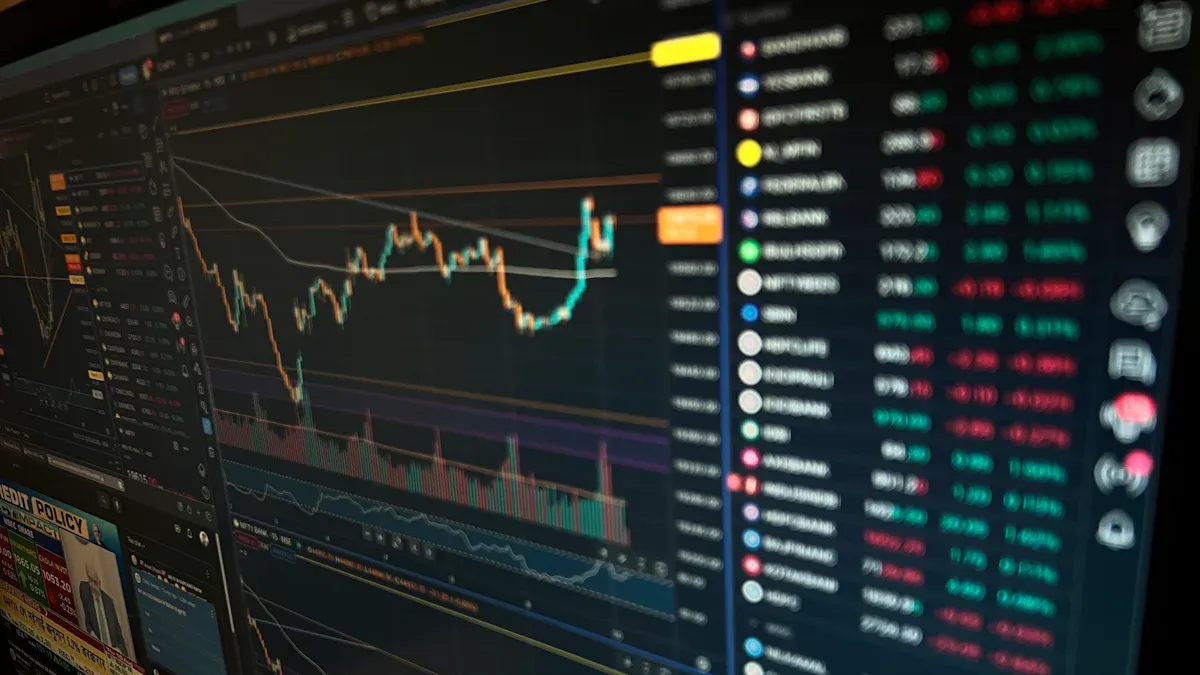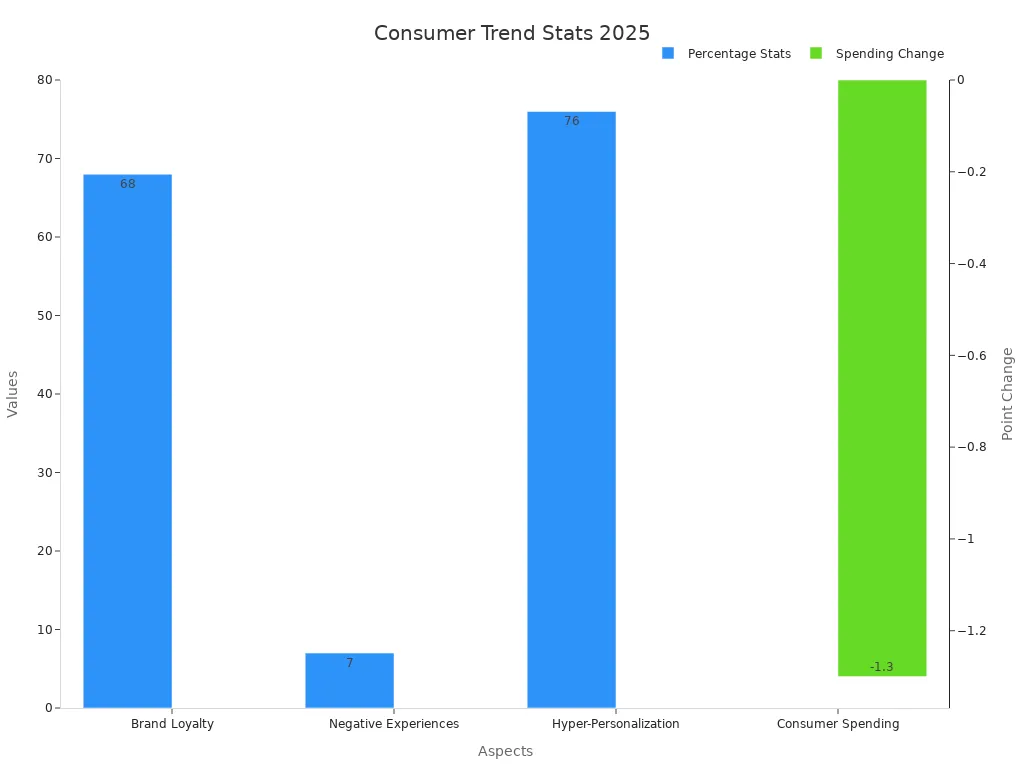Emerging Trends in Market Dynamics for 2025

Emerging market dynamics for 2025 indicate significant economic changes. The world economy is expected to grow due to lower inflation rates. This encompasses reduced inflation in developing markets and stable service costs. Companies that act swiftly and adapt will maintain a competitive edge. Understanding these dynamics enables businesses to navigate challenges and identify investment opportunities. It also aids them in formulating improved strategies and innovations.
Key Takeaways
Companies need to use new tools like AI and robots. This helps them work faster and save money in supply chains.
Being eco-friendly is important. Using green tech can make customers happy and help businesses grow.
Knowing about rising prices and loan rates is key. It helps companies do well in global markets and get investors.
Technological Innovations Shaping Market Dynamics

Artificial Intelligence and Automation in Supply Chains
Artificial intelligence (AI) and automation are changing how supply chains work. They make processes faster and cut costs for businesses. AI tools help with tasks like checking product quality, organizing warehouses, and planning transportation. For example, computer vision spots product flaws quickly, reducing waste and improving items. In warehouses, AI plans shorter routes for workers, saving time and boosting accuracy. Transportation systems use AI to find better routes, cutting fuel costs by 25% and speeding up deliveries by 30%. AI also improves last-mile delivery by lowering costs by 40% and scheduling deliveries more precisely.
Aspect | How It Helps |
|---|---|
Quality Control | AI finds defects faster, saving money and reducing waste. |
Warehouse Management | AI plans shorter paths for workers, making tasks quicker and more accurate. |
Transportation & Logistics | AI picks better routes, saving fuel and delivering faster. |
Last-Mile Delivery | AI lowers delivery costs and improves customer satisfaction. |
Returns Management | AI studies return patterns to reduce returns and improve service. |
These tools show how AI and automation are changing markets. They help businesses keep up with new trends and stay ahead of competitors.
Blockchain's Role in Decentralized Trade Systems
Blockchain technology is making trade systems safer and more efficient. It creates records that cannot be changed, reducing fraud and speeding up transactions. Banks are saving money with blockchain, and experts predict over $27 billion in yearly savings by 2030. Blockchain has already cut bank costs by 11%. A project between Wave and Barclays Bank showed its power, reducing transaction times from 7–10 days to just 4 hours.
Blockchain could save banks $27 billion a year by 2030.
Bank costs have dropped by 11% thanks to blockchain solutions.
Wave and Barclays Bank cut transaction times to 4 hours using blockchain.
Blockchain is changing global trade by offering secure and fast ways to do business internationally.
Green Technologies and Sustainable Solutions
Green technologies are helping businesses become more eco-friendly and creative. Companies and governments are working together to support these changes. Policymakers are creating rules and rewards to encourage green practices. Funding for research and pilot projects helps develop new ideas and fixes gaps in green technology investments.
Finding | What It Means |
|---|---|
Green Dynamic Capabilities (GDC) | Help businesses create better green strategies and ideas. |
Green Technology Adoption (GTA) | Improves business sustainability and green knowledge sharing. |
Mediation Analysis | Shows how green strategies connect different green practices and goals. |
Using green technologies helps businesses meet environmental goals and customer demands for ethical practices. It also boosts creativity and long-term success.
Data Analytics and Predictive Modeling for Market Insights
Data analytics and predictive modeling help businesses understand their customers and markets better. These tools improve how companies target customers, keep them loyal, and manage operations. Predictive analytics spots customers who might leave and helps prevent it. It also detects fraud by studying behavior patterns and reduces risks in banking. Businesses use data to learn customer preferences and market trends, gaining an edge over competitors.
Better customer targeting: Finds the right customers for products.
Higher customer retention: Helps keep customers from leaving.
Fraud prevention: Spots and stops fake transactions.
Smarter operations: Improves supply chain and inventory management.
Clearer decisions: Gives useful insights about customers and markets.
More revenue: Finds chances to sell more products.
Competitive advantage: Offers insights others may not have.
With predictive modeling, companies can plan inventory, adjust production, and improve sales strategies. These tools help businesses stay flexible and ready for market changes.
Economic and Geopolitical Trends Impacting Markets
Inflation, Interest Rates, and Global Economic Shifts
Inflation and interest rates affect how global markets work. High inflation makes money worth less, reducing buying power. This can scare away foreign investors. On the other hand, low interest rates encourage people to spend more. This boosts the economy and attracts foreign money. Central banks try to keep inflation around 2%. They change interest rates to control prices and keep economies steady.
Evidence Description | Impact on Global Market Dynamics |
|---|---|
High inflation weakens a country's currency. | This can hurt trade and reduce foreign investments. |
Low interest rates increase spending and growth. | This attracts foreign money and strengthens the economy. |
Rising inflation lowers currency value compared to others. | A weaker currency can scare off foreign investors. |
Inflation reduces money's buying power. | This makes the country less appealing for foreign investments. |
Interest rates usually follow inflation trends. When inflation rises, banks raise interest rates to slow price increases. If inflation is low or during a recession, banks lower rates to boost spending. These actions affect trade, investments, and market stability worldwide.
Supply Chain Resilience and Localization Strategies
Strong supply chains are important during uncertain times. Companies now focus on making supply chains more local. By using more suppliers and producing goods closer to customers, they reduce risks. This also helps them handle problems faster.
Unilever used demand forecasting to respond quickly to market changes.
Cisco created crisis plans and practiced them to avoid disruptions.
Toyota made production local and used more suppliers after the 2011 tsunami.
These examples show how strong supply chains help businesses. Toyota recovered faster than others after the tsunami by using local production. Companies that focus on resilience and localization can handle market changes better.
Geopolitical Tensions and Their Effect on Trade
Geopolitical issues change how countries trade with each other. Tariffs between big economies like the U.S. and China have changed trade patterns. In 2025, the U.S. set tariffs as high as 145%, and China responded with 84% tariffs.
Country | Tariff Percentage | Year |
|---|---|---|
U.S. | 145% | 2025 |
China | 84% | 2025 |
These tariffs make goods more expensive for businesses and buyers. Companies must rethink their supply chains and where they get materials. Political tensions also affect currency values and investments. Businesses need to stay flexible and informed to handle these challenges.
Emerging Markets and Growth Opportunities
Emerging markets still offer chances for growth, even with slowdowns. The Emerging Market PMI Output Index was 52.0 in April, down from 52.6 in March. This shows slower growth but still expansion. These markets are key to global growth, unlike developed markets with little progress.
India's factories show this potential, with the second-fastest export growth in 14 years. This proves some emerging markets are driving global growth. Companies investing in these areas can benefit from their growth and shape future markets.
Changing Consumer Habits and Market Patterns
Focus on Sustainability and Ethical Choices
People care more about eco-friendly and fair practices when shopping. Brands using green methods and honest actions attract these buyers. Studies show many support green shopping but don’t always act on it. For example, Portuguese Gen Z likes sustainability but struggles to buy green products. Companies that focus on eco-friendly practices earn trust and loyalty.
Study | Findings |
|---|---|
Wiederhold and Martinez | Caring for the planet boosts green shopping attitudes. |
Wang et al. | Good attitudes don’t always lead to green purchases. |
Saleem et al. | Knowing about green products affects buying choices. |
Habib et al. | Eco-friendly actions positively change consumer decisions. |
Brands that close the gap between green ideas and actions will lead this market trend.
Want for Personalization and Custom Products
Shoppers now expect products and services made just for them. They want experiences that match their personal likes. Research shows 66% of people leave brands that don’t offer this. Also, 63% are more likely to buy from brands with relevant content. Using smart data helps businesses earn more money and keep customers loyal.
Statistic | Value |
|---|---|
People wanting special offers | 52% |
66% | |
Higher earnings from smart data strategies | 5-8x |
By offering unique experiences, brands can build stronger connections and grow.
Online Shopping and Digital Growth
Online shopping is changing how people buy things. In 2022, global online sales hit $5.7 trillion, making up 20.8% of all sales. By 2025, this number will rise to 24.5%. Stores with better digital tools earn 3.3 times more than those without. Flexible options like Buy Online, Pick Up In Store (BOPIS) grew 28% in one year, giving shoppers more convenience.

Using AI in stock management helps stores avoid running out of items by 50% and cuts inventory costs by 30%. These changes show how important digital tools are for market growth.
Generational Changes in Buying Habits
Different age groups are shaping how people shop. Millennials and Gen Z are leading with their love for honesty, clear communication, and eco-friendly choices. Gen Z, making up 15% of the UK population, likes fast and digital shopping. Their careful spending comes from seeing economic problems and social challenges.
73% of business buyers are Millennials, showing a big shift in habits.
Younger shoppers prefer influencer advice and short videos to find products.
Gen Z chooses brands that match their values, like eco-friendly and fair practices.
Companies that follow these generational trends will find new chances to grow in the market.
Industry-Specific Trends in Market Dynamics
Innovations in Healthcare and Biotechnology
Healthcare and biotechnology are changing fast with new technology. Personalized medicine is now common, matching treatments to people's genes. This makes treatments work better and causes fewer side effects. Synthetic biology is also growing, helping create new medicines and eco-friendly products.
AI is speeding up drug creation by finding key markers and improving processes. It helps discover drugs faster and makes clinical trials more effective. Big data also plays a big role by matching treatments to patients' needs. The U.S. spent $19 billion on electronic medical records, showing how important big data is in healthcare.
Note: Aducanumab, a new drug for Alzheimer’s, shows promise. It slows down the disease, proving biotechnology can solve tough health problems.
Disruption in Retail and E-commerce
Retail and e-commerce are changing quickly with digital tools. Online shopping keeps growing, and by 2025, it will make up 24.5% of all sales. Stores using AI for inventory cut stockouts by 50% and save 30% on costs. Flexible shopping options like Buy Online, Pick Up In Store (BOPIS) grew by 28%, making shopping easier.
Brands using personalization tools are doing well. Studies show 66% of shoppers leave brands without personal experiences. But companies using smart data earn 5-8x more. These changes show why digital strategies are key for retail success.
Trends in Energy and Renewable Resources
The energy industry is using more renewable resources. In 2023, renewable energy grew by 510 GW, with solar power making up 75%. This is the fastest growth in 20 years. By 2024, it’s expected to grow by 550 GW, thanks to more solar panels in homes and businesses.
Going green also saves money. Good policies and teamwork could save $2 trillion yearly and improve energy use by 31% by 2030. These changes show how being eco-friendly helps both the planet and the economy.
The Future of Financial Services and Fintech
The financial world is using fintech to work better and faster. Blockchain cuts banks' costs by 30%, saving over $10 billion each year. Fintech tools also make financial data 95% more accurate, helping with smarter decisions.
Statistic Description | Value |
|---|---|
Global fintech market growth (2025–2034) | $280B to $1,382B |
Projected sustainable finance market size (2029) | $18.8 trillion |
Sustainable finance is growing, with a market size of $18.8 trillion by 2029. This shows people want financial solutions that care about the environment. Fintech is changing finance, offering new tools for businesses and customers.
JUSDA's Role in Changing Market Dynamics
JusTrade's Effect on Global Trade and Customs
JusTrade has changed global trade by making customs easier. Its smart software uses AI and big data to improve processes. This tool connects buying, shipping, customs, and finance teams for smooth work. Businesses get faster customs checks, fewer mistakes, and better rule-following. JusTrade’s skills in bonded trade and cross-border shipping make it a top player.
The platform’s smart tools, like sorting goods and tracking shipments, boost speed. For example, JusTrade’s bonded zone expressway cuts wait times at customs. Its self-check-in system for vehicles speeds up border crossings, saving time and money. Handling over 1.4 million import-export forms yearly, JusTrade keeps its clients’ production running smoothly.
JUSDA's Supply Chain Help for Growing Markets
JUSDA solves problems in growing markets with custom supply chain plans. Its teamwork platform uses AI and blockchain to improve shipping systems. This lowers costs and makes things clearer. JUSDA helps industries like electronics, cars, and fast-moving goods handle tricky supply chains.
Growing markets often deal with different customs rules and shipping delays. JUSDA’s know-how ensures smooth operations in these areas. Its tools predict demand, helping businesses match production to market needs. By focusing on local solutions and strong systems, JUSDA helps companies succeed in changing markets.
JusLink for Real-Time Supply Chain Tracking
JusLink gives live updates on supply chain activities. This smart tool uses IoT, cloud tech, and big data. Businesses can check stock levels, shipment progress, and customs steps. JusLink’s prediction tools spot problems early, helping companies act quickly.
For example, JusLink’s transport tracking lets businesses follow shipments in real time. This lowers risks and improves delivery accuracy. Companies using JusLink work better together and run more smoothly. Its easy-to-use design makes it accessible for clients worldwide.
JUSDA's Success Stories in Industry Solutions
JUSDA’s solutions for specific industries have shown great results. For example, its work with Sharp improved global e-commerce shipping. Using JUSDA’s teamwork platform, Sharp cut shipping costs by 20% and sped up order handling. This shows JUSDA’s ability to solve tough supply chain issues.
In the car industry, JUSDA’s tools have improved production and delivery. Its demand prediction tools ensure parts arrive on time. These examples show JUSDA’s focus on new ideas and quality. Companies in many industries trust JUSDA to work better and grow.

JUSDA Solutions
To provide you with professional solutions and quotations.
To succeed in 2025, businesses need to adapt and innovate. Important trends include AI, eco-friendly practices, and digital changes.
96% of companies are changing to stay competitive.
73% plan more changes, showing the need for new ideas.
CEOs using AI expect revenue to grow by 8.7% yearly.
Following these trends helps businesses stay strong and grow.
See Also
Five Key Trends Shaping Future Supply Chain Efficiency
Discovering How Technology Influences Current Market Trends
Achieving Supply Chain Success with Five Market Trends
Sustainability Insights: Robotics Trends in Supply Chain Management
